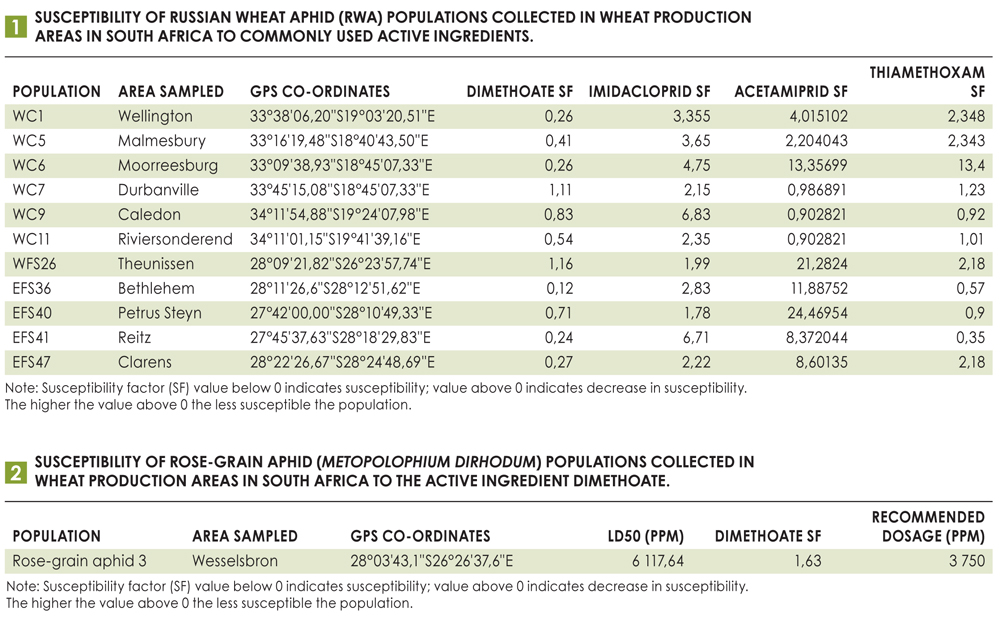
The aim of chemical control is to keep pest numbers on the crop below damaging levels that will lead to economic loss. Because all aphid species can be controlled with chemical insecticides, it is one of the most prevalent management strategies used on grain aphids in wheat so far.
Organophosphates and neonicotinoids are the most widely used insecticides. The most used insecticides will, however, eventually result in insecticide resistance in aphid species. Multiple treatments and increased doses of insecticide have previously resulted in resistance in aphid species to several insecticides and this resistance is a major cause of failure to control aphids on wheat. Russian wheat aphid (RWA, Diuraphis noxia) samples from wheat production areas were screened against commonly used active ingredients utilised against grain aphids on wheat.
Russian wheat aphid
RWA populations from different areas showed different levels of susceptibility to dimethoate. There was a significant decrease in the susceptibility of populations from the Durbanville area in the Western Cape and irrigation wheat in the Theunissen area (Table 1). All the RWA populations screened showed a decrease in susceptibility to imidacloprid (Table 1). RWA populations from different areas showed different levels of susceptibility to acetamiprid. There was a significant decrease in the susceptibility of populations in the Swartland area (Wellington, Malmesbury, Moorreesburg) in the Western Cape, irrigation wheat in the Theunissen area, and irrigation wheat in the Eastern Free State (Table 1).
 Populations of RWA from different areas showed different levels of susceptibility to thiamethoxam. There was a significant decrease in the susceptibility of populations from the Durbanville, Rûens (Riviersonderend) and Swartland (Wellington, Malmesbury, Moorreesburg) areas in the Western Cape, and irrigation wheat in the Theunissen (WFS) and Clarens (EFS) areas (Table 1).
Populations of RWA from different areas showed different levels of susceptibility to thiamethoxam. There was a significant decrease in the susceptibility of populations from the Durbanville, Rûens (Riviersonderend) and Swartland (Wellington, Malmesbury, Moorreesburg) areas in the Western Cape, and irrigation wheat in the Theunissen (WFS) and Clarens (EFS) areas (Table 1).
Rose-grain aphid
There were also reports of high infestations of rose-grain aphid (Metopolophium dirhodum) in dryland wheat in the Western Free State in the 2023 season. Wheat fields were treated with insecticides with the active ingredient dimethoate. This treatment had no effect on the population of rose-grain aphid present and insecticide resistance in rose-grain aphid populations was suspected. Samples of these aphids were screened for insecticide resistance against the active ingredient dimethoate (Table 2).
Insecticide resistance screening indicated that the LD50 for dimethoate against this population of rose-grain aphid was 6 117,64 ppm (Table 2). This is higher than the recommended dosage of 3 750 ppm. The screened population showed a SF of 1,63 (Table 2) indicating a decrease in susceptibility of the population against the active ingredient dimethoate.
 The results indicate that the suspicion of resistance against commonly used insecticides in populations of grain aphids on wheat in wheat production areas of South Africa is warranted. This implies that the aphid management programmes in the areas where these populations occur are not effective anymore. The situation in each area needs to be assessed and different management programmes need to be established.
The results indicate that the suspicion of resistance against commonly used insecticides in populations of grain aphids on wheat in wheat production areas of South Africa is warranted. This implies that the aphid management programmes in the areas where these populations occur are not effective anymore. The situation in each area needs to be assessed and different management programmes need to be established.



























